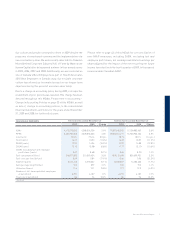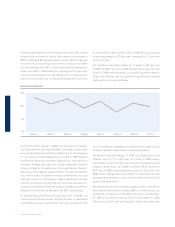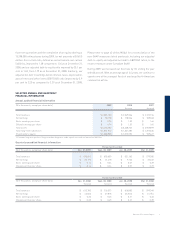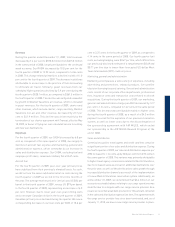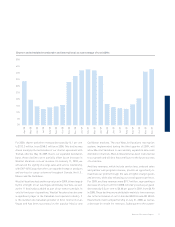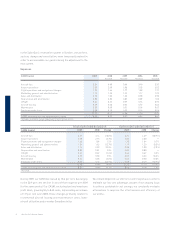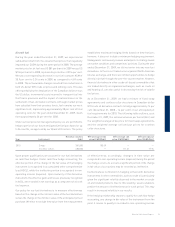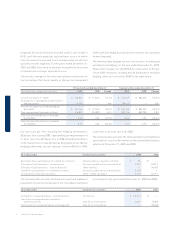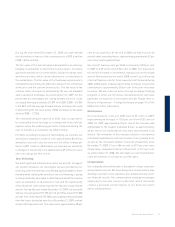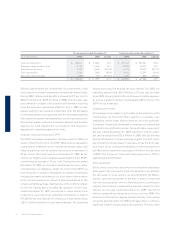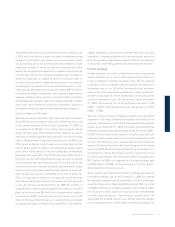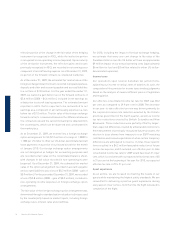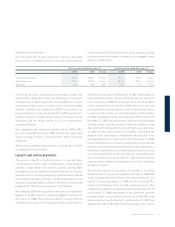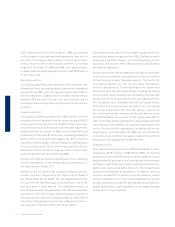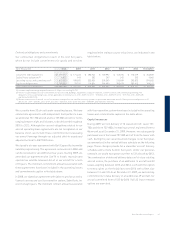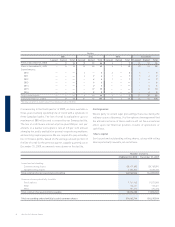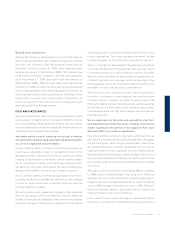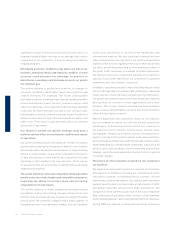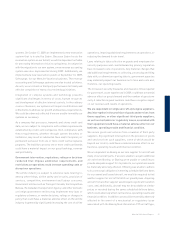Westjet 2009 Annual Report Download - page 47
Download and view the complete annual report
Please find page 47 of the 2009 Westjet annual report below. You can navigate through the pages in the report by either clicking on the pages listed below, or by using the keyword search tool below to find specific information within the annual report.
WestJet 2009 Annual Report 17
cent of our total fl eet. At the end of 2008, we had a total of 24
aircraft under operating leases, representing approximately 32 per
cent of our total registered fl eet.
Our aircraft leasing costs per ASM increased by 18.0 per cent
in 2009 to 0.59 cents, from 0.50 cents in 2008. The majority of
this variance related to incremental leasing costs on the leased
aircraft delivered since the end of 2008, as well as a full period
of aircraft leasing costs for three leased aircraft delivered during
2008. Additionally, unfavourable foreign exchange movements
contributed to approximately 30 per cent of the year-over-year
increase. We also have an active foreign exchange hedging
program to offset our US-dollar-denominated aircraft lease
payments on a portion of our leased aircraft. Please refer to
Results of Operations – Foreign Exchange on page 19 of this
MD&A for further information.
Maintenance
Our maintenance costs per ASM were 0.55 cents in 2009,
representing an increase of 10.0 per cent from 0.50 cents in
2008. For 2009, approximately 20 per cent of this increase was
attributable to the weaker Canadian dollar, as approximately
40 per cent of our maintenance costs were denominated in US
dollars. The remainder of this increase related to incremental
scheduled maintenance visits as a result of our growing fl eet,
as well as the increased number of aircraft off warranty. As at
December 31, 2009, 51 out of 86 aircraft, or 59.3 per cent, were
off warranty, compared to 36 out of 76 aircraft, or 47.4 per cent,
as at December 31, 2008. We anticipate our unit maintenance
costs will continue to increase as our fl eet ages.
Compensation
Our compensation philosophy is designed to align corporate
and personal success. We have designed a compensation plan
whereby a portion of our expenses are variable and are tied to
our fi nancial results. Our compensation strategy encourages
employees to become owners in WestJet, which inherently
creates a personal vested interest in our financial results
and accomplishments.
During the year ended December 31, 2009, we cash-settled
fuel derivatives in favour of the counterparties of $29.6 million
(2008 – $10.6 million).
The fair value of the fuel derivatives designated in an effective
hedging relationship is determined using inputs, including
quoted forward prices for commodities, foreign exchange rates
and interest rates, which can be observed or corroborated in
the marketplace. The fair value of the fi xed swap agreements is
estimated by discounting the difference between the contractual
strike price and the current forward price. The fair value of the
costless collar structures is estimated by the use of a standard
option valuation technique. As at December 31, 2009, for the
period that we are hedged, the closing forward curve for crude
oil ranged from approximately US $79 to US $84 (2008 – US $45
to US $67) with the average forward foreign exchange rate used
in determining the fair value being 1.0536 US dollars to Canadian
dollars (2008 – 1.2136).
The estimated amount reported in AOCL that is expected to
be reclassifi ed to net earnings as a component of aircraft fuel
expense when the underlying jet fuel is consumed during the
next 12 months is a loss before tax of $6.7 million.
For 2010, excluding the impact of fuel hedging, we estimate our
sensitivity to changes in crude oil to be approximately $6 million
annually to our fuel costs for every one US-dollar change per
barrel of WTI crude oil. Additionally, we estimate our sensitivity
to changes in fuel pricing to be approximately $9 million for every
one-cent change per litre of fuel.
Aircraft leasing
Our most signifi cant infrastructure cost is our aircraft. To support
our growth initiatives, we investigate various alternatives for
fi nancing, with the intention of achieving optimal balance sheet
fl exibility while realizing the benefi ts of low-cost fi nancing. Leasing
is often an attractive alternative to debt-fi nanced aircraft for reasons
such as alleviation of obsolescence risk and the significantly
reduced upfront cash outlay required for deposits on purchased
aircraft. During the year ended December 31, 2009, we assumed
delivery of seven leased 737-700 aircraft and three leased 737-800
aircraft. One of the leased 737-800s was subsequently purchased
from the lessor during the year. As at December 31, 2009, we had
a total of 33 leased aircraft. This represents approximately 38 per


